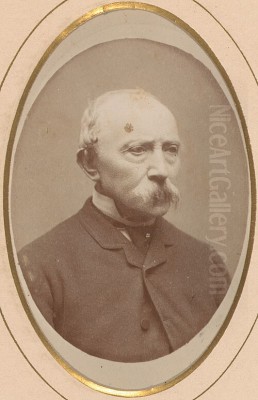
Adrianus Eversen stands as one of the most accomplished and cherished painters of the Dutch urban landscape in the 19th century. Born in Amsterdam in 1818 and passing away in Delft in 1897, his life spanned a period of significant change in the Netherlands, yet his art primarily captures a timeless, often idealized vision of Dutch towns and cities. He specialized in cityscapes and street scenes, developing a remarkable ability to evoke the characteristic atmosphere of 19th-century Holland, blending meticulous observation with a touch of romantic imagination. His work remains highly sought after, celebrated for its detail, warmth, and nostalgic charm.
Early Life and Artistic Formation
Johannes Adrianus Eversen was born in Amsterdam on January 13, 1818. His early life coincided with the burgeoning Romantic movement in Dutch art, which saw a renewed interest in the nation's Golden Age heritage but also explored more personal, atmospheric interpretations of landscape and daily life. While details of his earliest artistic inclinations are scarce, it is known that he received crucial training from prominent artists who shaped his development.
His most significant teachers were Hendrik Gerrit ten Kate and Cornelis Springer. Ten Kate (1803-1856) was known for his genre scenes, often interiors or historical settings, executed with careful detail. From him, Eversen likely honed his skills in depicting figures and narrative elements within a scene. Cornelis Springer (1817-1891), born just a year before Eversen, became arguably the most famous Dutch cityscape painter of the era, renowned for his almost photographically accurate depictions of specific locations. Both Eversen and Springer studied under Ten Kate, establishing an early connection between these two future masters of the urban view.
Studying with Springer, or at least alongside him and under the same influences, was particularly formative. Springer was himself a pupil of the leading landscape painter Andreas Schelfhout (1787-1870), known for his winter scenes and meticulous technique. Springer adapted this precision to the urban environment. Eversen absorbed the lessons in detailed rendering, perspective, and the effective use of light and shadow that were hallmarks of Springer's style. However, Eversen would soon diverge, developing his own distinct approach to the cityscape.
The Artistic Style of Adrianus Eversen
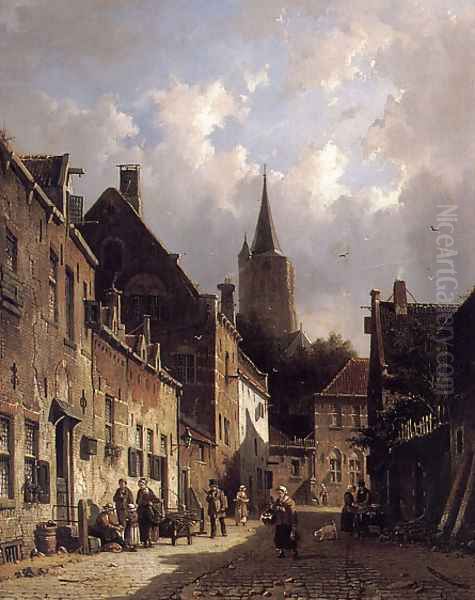
While trained in the precise manner favoured by artists like Springer, Adrianus Eversen developed a style that, while highly detailed, offered a different kind of viewing experience. His approach was characterized by several key features that distinguished his work and contributed to its enduring appeal.
A Unique Blend of Reality and Imagination
Unlike Cornelis Springer, who typically aimed for topographical accuracy, often identifying the specific city and street depicted, Eversen frequently composed his townscapes more freely. He excelled at creating what might be termed capriccios – imaginary views assembled from real architectural elements observed in various Dutch towns. He would sketch buildings, canals, and street furniture during his travels through cities like Amsterdam, Haarlem, Utrecht, Zwolle, and Delft, and then combine these elements in his studio to create harmonious, idealized compositions.
This approach allowed him greater artistic freedom. He could manipulate perspective, arrange buildings for optimal visual effect, and control the play of light and shadow without being strictly bound by reality. The result is a vision of the Netherlands that feels authentic and familiar, capturing the essence of Dutch architecture and urban life, yet often representing no single identifiable place. His paintings evoke a generalized, perhaps nostalgic, sense of "Old Holland."
Mastery of Light and Atmosphere
A defining characteristic of Eversen's work is his skillful handling of light and atmosphere. He was particularly adept at depicting sunlight, often showing bright rays illuminating parts of a street or square while other areas remain in cool shadow. This contrast adds depth and drama to his scenes. He favoured a warm colour palette, rich in ochres, reds, and browns, which contributes to the inviting and often cheerful mood of his paintings.
His ability to render different weather conditions and times of day, from bright summer afternoons to the crisp air of winter, further enhances the atmospheric quality. The way light reflects off wet cobblestones after rain, filters through hazy air, or defines the sharp edges of buildings under a clear sky are all rendered with sensitivity. This focus on light and atmosphere imbues his work with a palpable sense of place and time, contributing significantly to the "typical 19th-century Dutch atmosphere" for which he is renowned.
Detail and Texture
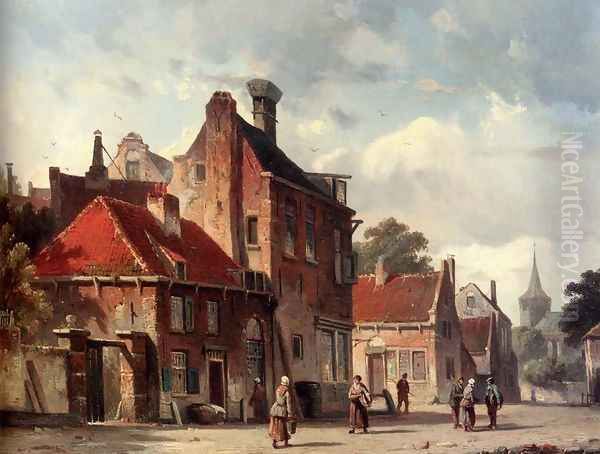
Eversen shared with Springer a commitment to meticulous detail, but perhaps with a slightly softer touch. His paintings are filled with carefully observed elements: the intricate brickwork of gabled houses, the texture of stone bridges, the reflections in canal water, the wares displayed in shop windows, and the varied costumes of the figures populating his scenes. This attention to detail invites close inspection and rewards the viewer with a wealth of visual information.
He rendered textures convincingly, differentiating between wood, stone, fabric, and water. This technical skill, combined with his compositional arrangements and use of light, gives his paintings a strong sense of realism, even when the scene itself is a composite creation. The overall effect is one of richness and verisimilitude that draws the viewer into the world he depicts.
Themes and Subjects
Adrianus Eversen's oeuvre is remarkably consistent in its focus on the Dutch urban environment. His primary subjects were the streets, squares, canals, and buildings that defined the character of towns and cities in the Netherlands.
The Dutch Townscape
Eversen's canvases are typically filled with the architectural motifs characteristic of the Netherlands: tall, narrow gabled houses lining canals or streets, imposing church towers rising in the background, humpbacked bridges spanning waterways, and bustling market squares. He captured the unique verticality and density of Dutch urban spaces. While often imaginary composites, his scenes frequently evoke the specific character of cities he knew well, such as Amsterdam with its grand canals or Delft with its more intimate settings.
Canals feature prominently, reflecting the importance of waterways in Dutch life and urban structure. Boats – ranging from small dinghies to larger barges – are often included, adding another layer of activity and visual interest. The interplay between architecture, water, and sky is a constant theme, handled with his characteristic sensitivity to light and reflection.
Daily Life in the City
Crucially, Eversen's townscapes are rarely empty architectural studies. They are almost always animated by human figures engaged in the activities of daily life. These figures, though small in scale compared to the buildings, are vital to the narrative and atmosphere of his paintings. We see shoppers browsing market stalls, merchants conducting business, women chatting on doorsteps, children playing in the street, and people crossing bridges or strolling along canals.
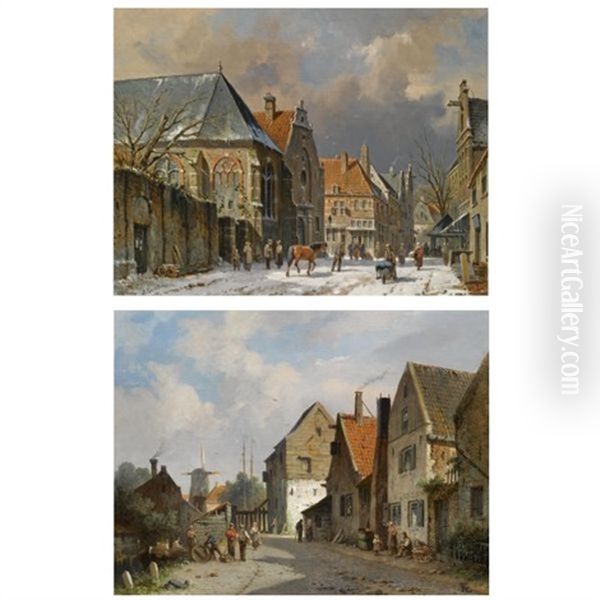
These figures add life, scale, and a sense of immediacy to the scenes. They represent the community inhabiting the urban spaces Eversen depicts. Works like Woman Gathering Firewood place a figure more prominently, highlighting the human element within the environment. His depictions of street markets are particularly lively, filled with vendors, customers, and goods, capturing the social and commercial heart of the town. This focus on everyday activities contributes significantly to the inviting, relatable quality of his art.
Eversen and His Contemporaries
Understanding Adrianus Eversen's contribution requires placing him within the context of 19th-century Dutch art and comparing his work to that of his peers, particularly Cornelis Springer.
The Shadow of Springer
Cornelis Springer remains the benchmark for 19th-century Dutch cityscape painting due to his incredible precision and topographical accuracy. Eversen, having trained alongside Springer and under similar influences, inevitably invites comparison. Both artists shared a love for the Dutch urban scene and possessed exceptional technical skill. However, their artistic goals differed.
Springer acted more like a visual historian, documenting specific locations with painstaking detail. His works often served as valuable records of cities undergoing modernization. Eversen, while equally detailed, acted more like a poet of the urban landscape. His freedom to compose and combine elements allowed him to prioritize mood, atmosphere, and aesthetic harmony over strict factual representation. While Springer's work might be admired for its accuracy, Eversen's often evokes a stronger emotional or nostalgic response. Both were highly successful, catering perhaps to slightly different tastes among collectors.
The Wider Dutch Context
The 19th century in the Netherlands saw various artistic trends. The Romantic landscape tradition, led by figures like Barend Cornelis Koekkoek (1803-1862) with his majestic forest and river scenes, and Andreas Schelfhout with his popular winter landscapes, formed an important backdrop. Eversen's focus on the urban environment set him apart from these dominant landscape painters.
Other artists specialized in different facets of Dutch life. Wouterus Verschuur (1812-1874) was renowned for his paintings of horses, often in stable or outdoor settings. Johannes Bosboom (1817-1891) dedicated himself almost exclusively to painting church interiors, exploring effects of light within grand architectural spaces. Genre painters like David Bles (1821-1899) depicted scenes of middle-class life, while Petrus van Schendel (1806-1870) gained fame for his atmospheric night markets illuminated by candlelight, offering a contrast to Eversen's typically sunlit views.

Eversen's work also resonates with the long tradition of Dutch cityscape painting dating back to the Golden Age (17th century). Masters like Jan van der Heyden (1637-1712) and Gerrit Berckheyde (1638-1698) had established the genre with their highly detailed and realistic views of Amsterdam, Haarlem, and other cities. While Eversen's style reflects 19th-century sensibilities, the fundamental interest in capturing the character and daily life of Dutch towns connects him to these illustrious predecessors. Even the intimate street and courtyard scenes of Pieter de Hooch (1629-1684) find an echo in Eversen's focus on the inhabited urban space.
Eversen was an active member of the Amsterdam artists' society Arti et Amicitiae ("Art and Friendship"), founded in 1839. This placed him at the heart of the city's artistic life, facilitating interaction and exchange with fellow painters, sculptors, and architects. Membership provided opportunities for exhibition and discussion, contributing to his professional standing.
Representative Works
While Eversen produced a large body of work, certain paintings exemplify his characteristic style and subjects. Attributing precise dates can sometimes be difficult, especially for his composite views, but titles and descriptions give a clear sense of his output.
Capturing the Urban Essence
_Dutch Street Scene_: This title represents a common theme. A typical example might show a narrow, sun-drenched street lined with gabled houses, perhaps leading towards a church tower. Small figures would populate the scene – a woman sweeping a doorstep, a dog trotting along, perhaps a cart delivering goods. The focus would be on the interplay of light and shadow on the varied facades and cobblestones.
_View of a Town_: Often featuring a canal or river in the foreground, these works showcase Eversen's skill in depicting water and reflections. Buildings would line the waterway, possibly including warehouses or prominent civic structures. Boats might be moored along the quay, and figures seen crossing a bridge or walking along the water's edge.
_A Dutch Town in Summer_: Evoking warmth and vibrancy, these paintings typically feature bright sunlight, clear skies, and lush foliage where present (e.g., trees along a canal). Market scenes often fall into this category, bustling with activity under the summer sun. The warm palette would be particularly emphasized.
_Street Scene in Haarlem by Night_: While less common than his sunlit scenes, Eversen did occasionally depict nocturnal or twilight views. These works allowed him to explore different effects of light, such as moonlight or the warm glow from windows. A painting with this title might focus on the silhouettes of buildings against the night sky, with perhaps a few illuminated windows suggesting life within. (Note: If dated 1818, this is incorrect as it's his birth year; the painting itself would be later).
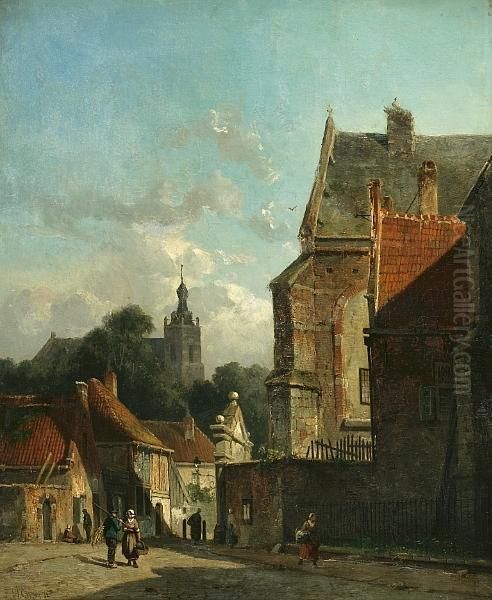
_Small View of Hans Town, Delft_ (1860-1866): This title suggests a more specific location, though Eversen might still have taken liberties. Delft, with its historic canals and association with Vermeer, provided rich subject matter. A "small view" implies an intimate scale, perhaps focusing on a particular corner or canal segment, rendered with his typical attention to detail and atmosphere.
_View Of A Town With Figures In A Sunlit Street_: This descriptive title perfectly encapsulates a core Eversen theme. It highlights the key elements: the urban setting, the presence of inhabitants, and his signature use of sunlight to animate the scene and create visual interest. Such works showcase his ability to balance architectural rendering with lively human detail.
These examples illustrate the recurring motifs and stylistic approaches in Eversen's work: the focus on Dutch architecture, the integration of daily life, the masterful use of light and shadow, and the creation of evocative, often idealized, urban atmospheres.
Professional Recognition and Later Life
Adrianus Eversen achieved considerable success during his lifetime. His paintings were popular not only in the Netherlands but also found eager buyers in Belgium and Great Britain. His membership in Arti et Amicitiae provided a platform for exhibiting his work regularly in Amsterdam. He also participated in exhibitions in The Hague, Leeuwarden, and internationally.
His appealing subject matter and meticulous technique resonated with the tastes of the burgeoning middle class and affluent collectors who appreciated the nostalgic charm and skilled execution of his townscapes. The market value of his work was significant during his lifetime and has remained strong. Auction results in the 21st century, such as a painting selling for between €50,000 and €70,000 as mentioned in the source material, attest to his enduring status among collectors of 19th-century European art.
Later in his life, Eversen moved from Amsterdam, living for a time in Rotterdam before eventually settling in Delft. It was in Delft, a city whose picturesque canals and historic buildings surely provided inspiration, that he passed away on December 1, 1897, at the age of 79.
Legacy and Influence
Adrianus Eversen left a significant legacy as one of the foremost painters of the Dutch cityscape in the 19th century. His work continues to be admired for its technical proficiency, atmospheric beauty, and evocative portrayal of Dutch urban life.
Shaping the View of Old Holland
Eversen's paintings contributed significantly to shaping a particular image of "Old Holland" – picturesque, orderly, and bathed in a warm, inviting light. While based on observation, his tendency to idealize and compose his scenes created a vision that resonated with national pride and a growing sense of nostalgia during a period of industrialization and change. His work helped preserve and popularize the visual charm of traditional Dutch towns.
Artistic Heirs
While Eversen did not establish a large school of direct followers in the way some other artists did, his influence can be seen. His nephew, Johannes Hendrik Eversen (1906-1995), studied with him. However, the younger Eversen became known primarily for his exquisite still life paintings, executed in a style reminiscent of the Dutch Golden Age masters like Willem Claesz Heda, rather than for cityscapes in the manner of his uncle Adrianus.
Eversen's broader influence lies in his contribution to the continuity and adaptation of the cityscape genre. His emphasis on atmosphere and light, even within a detailed framework, prefigures some concerns of later movements. Although his style remained largely within the bounds of Romantic realism, distinct from the looser brushwork and plein-air practices of the subsequent Hague School (with artists like Jacob Maris, Anton Mauve) or Amsterdam Impressionism (George Hendrik Breitner), his dedication to capturing the specific character and mood of the Dutch environment provided a touchstone for artists interested in similar themes.
Conclusion
Adrianus Eversen occupies a distinguished place in the history of Dutch art. As a master of the 19th-century townscape, he developed a unique and highly appealing style that balanced meticulous detail with compositional freedom and atmospheric sensitivity. He captured the quintessential character of Dutch towns and cities, populating them with scenes of everyday life rendered with warmth and charm. While often compared to his contemporary Cornelis Springer, Eversen forged his own path, creating idealized yet believable urban visions that prioritized mood and visual harmony. His membership in Arti et Amicitiae and the enduring popularity of his work in the Netherlands and abroad testify to his success and significance. Through his numerous paintings, Adrianus Eversen remains a beloved chronicler of the 19th-century Dutch urban scene, offering viewers a captivating glimpse into a world both real and imagined.